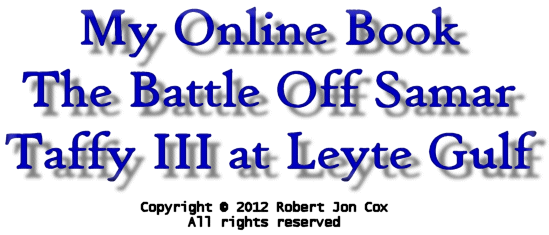
COMMENTS ARE ENABLED ON THE BOTTOM OF THE PAGE
Chapter 7
0707 to 0730
SANCTUARY, COUNTER-ATTACK,
AND DEFEND
Wednesday, October 25, 1944
|
Time-Line, Events, & Comments
|
|
0707 Heavy rain pours down across the decks of the leading escort carriers of Taffy III. Rear Admiral Sprague takes advantage of this opportunistic sanctuary and steers his task unit directly into its heart. Visibility decreases rapidly. Increasing in volume, heavy black funnel smoke combined with FS and FM (chemical) smoke from the escort carriers, destroyers, and destroyer escorts obstructs the Japanese line of sight. As a result of the natural and man-made screen, the accuracy of the heavy caliber Japanese gunfire decreases significantly. The multicolored shell splashes exploding near the warships of Taffy III decline significantly. A/C The smoke screen was used to great effect by all ships of Taffy III, albeit it was one of the few advantages they held. The destroyers and destroyer escorts zigzagged in and around the fleeing escort carriers, winding the smoke layers into a defensive shield. The hot, humid Philippine climate aided to combine the mixture of black fuel smoke and white chemical smoke, making them mix most effectively. Combined with the current intermittent rain squall, it greatly neutralized the Japanese gunfire accuracy and was a contributing factor to the escape of Taffy III...for the time being... |
CTU 77.4.3/COMCARDIV 25 Action Report At 0706, the enemy was closing with disconcerting rapidity, and volume and accuracy of fire was increasing. At this point, it did not appear that any of our ships could survive another five minutes of the heavy caliber fire being received, and some counteraction was urgently and immediately required. The Task Unit was surrounded by the ultimate of desperate circumstances. All escorts were ordered to attack the enemy with torpedoes. At this time, direct view of the enemy was obscured by smoke and results of our escort’s attack could not be ascertained, but it is believed that, regardless of hits, they succeeded in turning the battleships away at least momentarily, and created a diversion of immense value. About this time we intercepted a fairly heavy rain squall and while in it changed course to the right. The combination of rain and smoke made visibility very poor and enemy fire slackened and fell off in accuracy. |
0707 Aboard escort carrier ST LO, a salvo is observed to splash ahead of the ship, slightly off the starboard bow. A series of four shells splash and explode in a line, the first shell hitting the water about 200 yards from the ship.
A/C Help from Seventh Fleet surface forces, consisting of RADM Oldendorf’s Fire Support Group, the old, slow battleships, was about three hours away at the southern end of Leyte Gulf.
EVENT Local US anti-submarine patrols from the other Taffies attack the ships of Centre Force, strafing their decks and dropping depth charges.
A/C These planes were already in the air when Centre Force initially attacked Taffy III. As mentioned earlier, their pilots were untrained in anti-surface ship strikes, but certainly made up for their lack of anti-shipping training by their shear determination.
0708 Rear Admiral Sprague amplifies the composition of the enemy force, "WE ESTIMATE 4 BB'S AT LEAST 8 CRUISERS AND SOME OTHER UNIDENTIFIED UNITS - COURSE AND SPPED OF ENEMY 090 - 30 KNOTS".
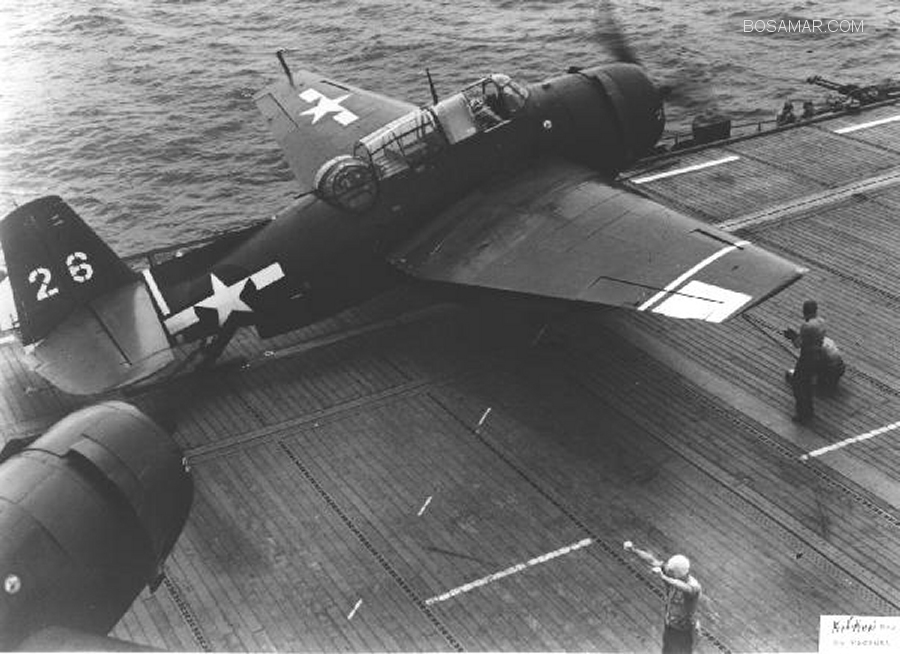
U.S. Navy Photograph
General Motors TBM-1C Avenger torpedo bomber of Composite Squadron VC-5
is prepared for launch aboard USS KITKUN BAY (CVE 71)
0708 Word is passed via TBS on the escort carriers of Taffy III, "All carriers launch all aircraft." Sixty-five fighters and forty-four TBM aircraft from the CVEs are launched. Several aircraft are unarmed or under-fueled due to their hasty launch. Only a handful of the bombers are armed with torpedoes. Escort carriers WHITE PLAINS and KITKUN BAY manage to launch General Motors FM-2 fighters which carry bombs.
|
A/C The flight deck and hanger crews of the escort carriers worked at a feverish pace to prepare their aircraft for flight, fighting the rain soaked decks, in addition to their Japanese foes. A/C The courage displayed by the American pilots was enormous. The fact that they were preparing to attack a powerful armored surface force with little or no armor piercing ordnance or formal training was extraordinary. It would be nearly impossible to stop the heavily armored Japanese warships without armor-piercing ordnance or torpedoes. After expending whatever ordnance they left their carriers with, many pilots made dry runs over the Japanese warships, breaking up their formations and interrupting their pursuit of the fleeing escort carriers. For the most part, this tactic worked well, significantly contributing to the final outcome of the battle. The American pilots first concentrated on the battleships since they were the most potent threat early in the battle. It was during this initial counter-attack that IJN BB KONGŌ’s main range finder was disabled by the American fighters. |
LT Dick Roby, USNR "After General Quarters was secured Gene Seitz and I were the "ready" VF (fighter) pilots; there were no VT (torpedo) pilots in that status at approximately 0655. Elmo Waring alerted us that the Japanese fleet was 24 miles away and to man all aircraft. I took time to get him on the intercom and told him to get the pilots out of the wardroom. By this time I got to the flight deck. I discovered Dugan was in #2, I was #3, Rocky Phillips was in #4. We took off as the ship was getting into the wind and were vectored NW of the Task Unit to intercept two destroyers. We made two sets of strafing runs on them, going down through a thin cloud cover. They apparently had no radar fire controlled AA as their fire was very poor. After the second run they turned around and retreated on a course of about 350 degrees." |
0708 A TBM-1C Avenger Torpedo-bomber of Composite Squadron VC-10 is brought up on deck via the forward elevator aboard CVE GAMBIER BAY.
0708 Another salvo, similar to the first, is seen aboard CVE ST LO, landing the same distance ahead slightly off the port bow.
EVENT Commander Evans rapidly closes the distance between IJN Cruiser Division Seven and DD JOHNSTON. She pushes through the water at flank bell, creating a large bow wave. A long line of thick black funnel smoke is laid behind her as she goes.
A/C JOHNSTON had already closed the approaching Japanese fleet by about nine miles since the initial contact with Centre Force. Commander Evans was displaying his true fighting spirit which led the way for the other screening ships of the task unit throughout the morning. The small Americans warships were commanded fearlessly in the face of their superior enemy.
EVENT Several of the pursuing Japanese warships are forced to take evasive maneuvers in lieu of air attack, interrupting their pursuit of the escort carriers of Taffy III.
A/C This was the norm for most of the engagement. The Japanese had no idea what the attacking aircraft carried ordnance-wise and therefore had to treat all aircraft as a potential threat.
0709 TBS - v Taffy 3, "ALL CARRIERS LAUNCH ALL AIRCRAFT."
0710 Steaming in single column at 33 knots, IJN heavy cruisers KUMANO, SUZUYA, TONE, and CHIKUMA of Cruiser Division Seven close the escort carriers on a southeasterly heading. They are the nearest threat to Taffy III. While maintaining their current course, they are on the verge of outflanking the escort carriers on their port quarter.
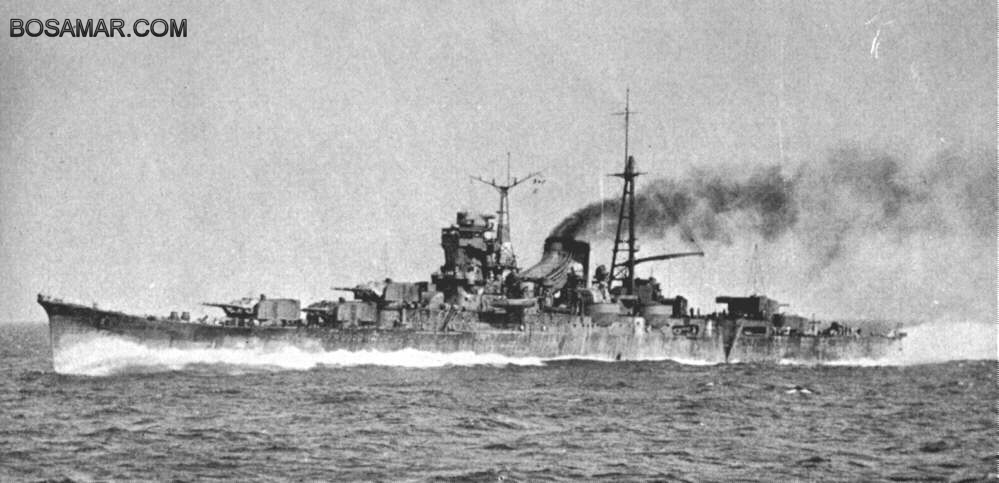
National Archives Photograph
Imperial Japanese Navy heavy cruiser HIJMS SUZUYA
0710 The TBM-1C Avenger Torpedo-bomber of Composite Squadron VC-10 brought up on deck only a few minutes earlier is launched via the catapult loaded with a torpedo.
0710 Six TBM-1C torpedo bombers of Composite Squadron VC-5 are launched from CVE KITKUN BAY.
0710 The deployment of the screening ships in the rear of the CVE formation for the purpose of generating a smoke screen is now complete. All escort vessels now effectively contribute to the smoke screen as more ships enter the rain squall.
|
0710 Destroyer JOHNSTON charges the enemy cruisers at 30 knots and fires her forward 5-inch guns at Cruiser Division Seven flagship CA KUMANO at 18,000 yards, scoring several hits on her superstructure. Heavy cruisers KUMANO, SUZUYA, TONE, and CHIKUMA are in position to return fire and do so with main armament of 8-inch guns. All shells miss their small target, about nine miles away and closing rapidly. Word is passed aboard JOHNSTON, "STANDBY FOR TORPEDO ATTACK TO STARBOARD". A/C Under heavy fire Commander Evans wanted to get his primary weapons off before taking serious damage. Torpedoes were set on low speed (27 knots) to insure the Japanese warships were within range should JOHNSTON become disabled on her torpedo run at too great a distance. 0710 TBS - v Taffy 3, "ALL SHIPS IN THIS GROUP TURN TO COURSE 080." 0710 TBS - Taffy 3 v FIDO, "I HAVE BEEN HIT." A/C WHITE PLAINS, aka "FIDO", reported an armor-piercing hit which passed completed through her thin hull without exploding, causing little or no damage. Her speed was unimpeded. |
LT Robert C. Hagen, USNR "We were engaging many ships at only medium ranges. There were several occasions where the ship still could have crept away and escaped further damage which she was continuing to receive. At this time we had taken 12 to 14 hits. We had two guns that were fully in operation, two others that could have fired only in manual. Our maximum speed was still 15 knots. Killed and wounded littered our decks. The Captain, Commander Evans, was injured rather severely at 0730, two and a half hours before we abandoned ship, to the extent of a couple of fingers blown off, an unknown number of shrapnel holes in his back and superficial wounds about his face and neck, all of which were drawing considerable blood. Despite these things the Captain fought the ship as no other man has ever fought a ship." |
0710 Japanese battleships YAMATO , NAGATO, and HARUNA cease fire on the fleeing U.S. warships due to a lack of visibility caused by the smoke screen and rain squall. Aggressive BB KONGŌ to the northward, clear of the smoke and rain, continues to fire on the American task unit.
0710 Japanese Destroyer Squadron Two, led by CL NOSHIRO with seven highly capable destroyers, is ordered to follow in the rear of the formation.
A/C The decision not to use these destroyers aggressively early in the battle generated quite a bit of controversy with strategists and historians. Rightfully so, their removal from the early stages of the battle were another crucial decision which led to the escape of the American task unit.
0710 A Japanese warship, bearing 325° T, distance 14 miles, is picked up on radar by DE DENNIS.
| FLETCHER CLASS MARK 37 FIRE CONTROL SYSTEM |
|
The FLETCHER Classs destroyer Mark 37 Fire Control System enabled remote and automatic targeting of its 5-inch guns against ships, aircraft, and shore targets, with or without the aid of radar or optical sighting. The major components were 1) a manned director, 2) computer, 3) Stable Element, 4) FD Radar Equipments, and 5) plotting room. In contrast to the U.S. radar aided system, the Japanese relied on averaging optical rangefinders, they lacked gyros to sense the horizon, and required manual handling of follow-up fire control solutions. 1) The Mark 37 Director, which resembles a turret with "ears" rather than guns, tracked the present position of the target in bearing, elevation, and range. 2) The Mark 1A Fire Control Computer was an electro-mechanical analog ballistic computer. Its function was to automatically aim the guns so that a fired projectile would collide with the target. 3) The Mark 6 Stable Element, which in contemporary terminology would be called a vertical gyro, stabilized the sights in the director, and provided data to compute stabilizing corrections to the gun orders. 4) The Mark 12 FD Radar Equipments provided range, bearing, and elevation information for both surface and air targets. Its reliable range was 30,000 yards. 5) The Plotting Room contained all of the fire control equipment needed to aim and shoot at targets. It contained the Mark 1A fire control computer, Mark 6 Stable Element, FD radar controls and displays, parallax correctors, a switchboard, and people to operate it all. |
EVENT From the rear of the Japanese formation, battleships and light cruisers open fire upon DD JOHNSTON, all missing. Destroyer JOHNSTON expends over 200 rounds of 5-inch ammunition during her initial approach to the Japanese warships of Cruiser Division Seven. An excellent gunfire solution was contained throughout and numerous hits were visually observed. A continuous ladder of two hundred yards, subsequently out to one hundred yards, was used. JOHNSTON's action report states, "...It is believed that this heavy cruiser was severely damaged by at least forty-five inch shells (common projectiles)...."
A/C Lone JOHNSTON was initially the nearest ship to the approaching Japanese. Once she was within range of the heavy cruisers’ guns, she was forced to maneuver wildly during her initial advance on the cruiser column.
0711 TBS - Taffy 2 v Taffy 3, "ENEMY BEARS 090 SPEED 30, AND 070 SPEED 30 KNOTS, DISTANCE 20 MILES."
A/C From flagship FANSHAW BAY, RADM Sprague reports the enemies status to RADM Stump of Taffy II.
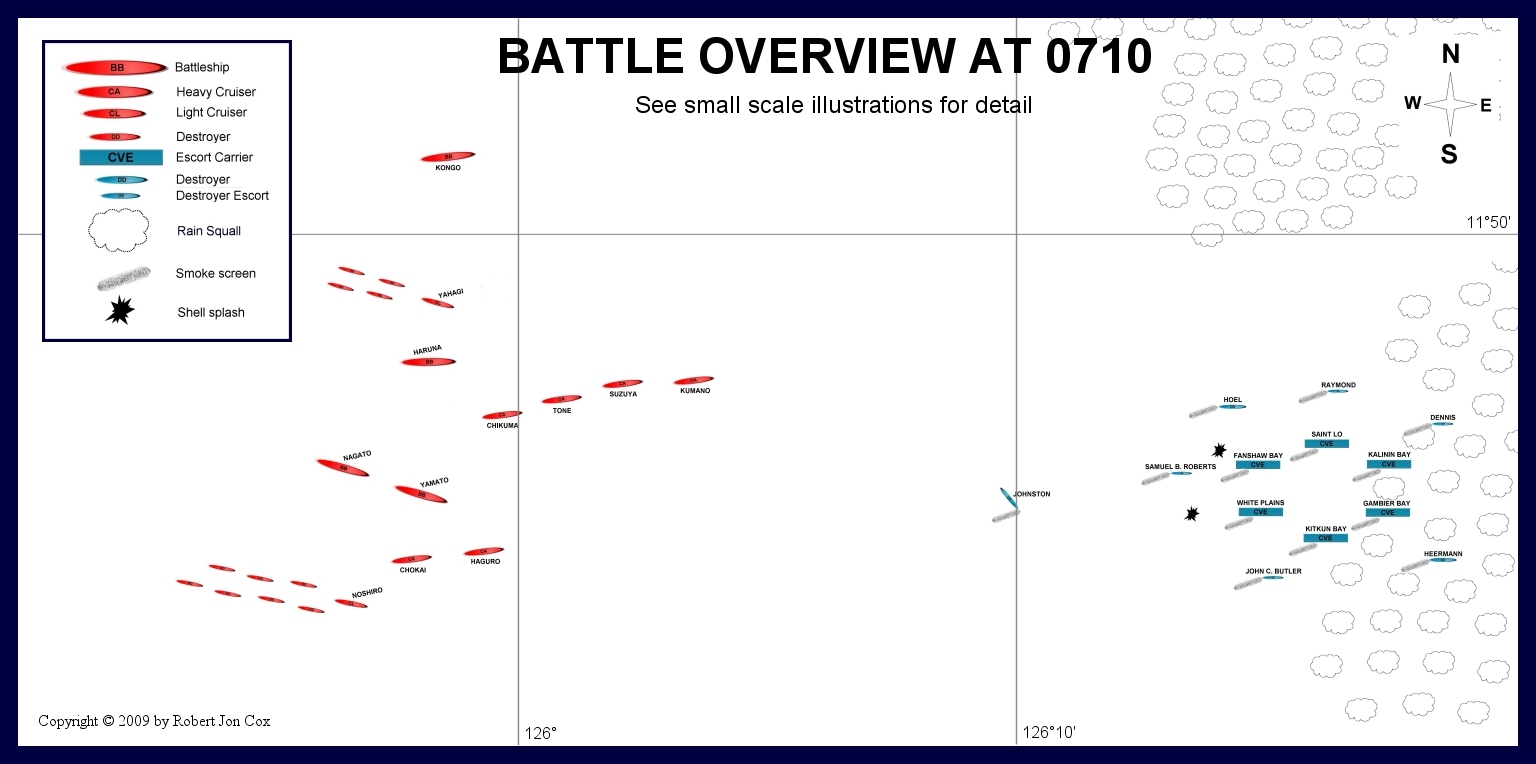
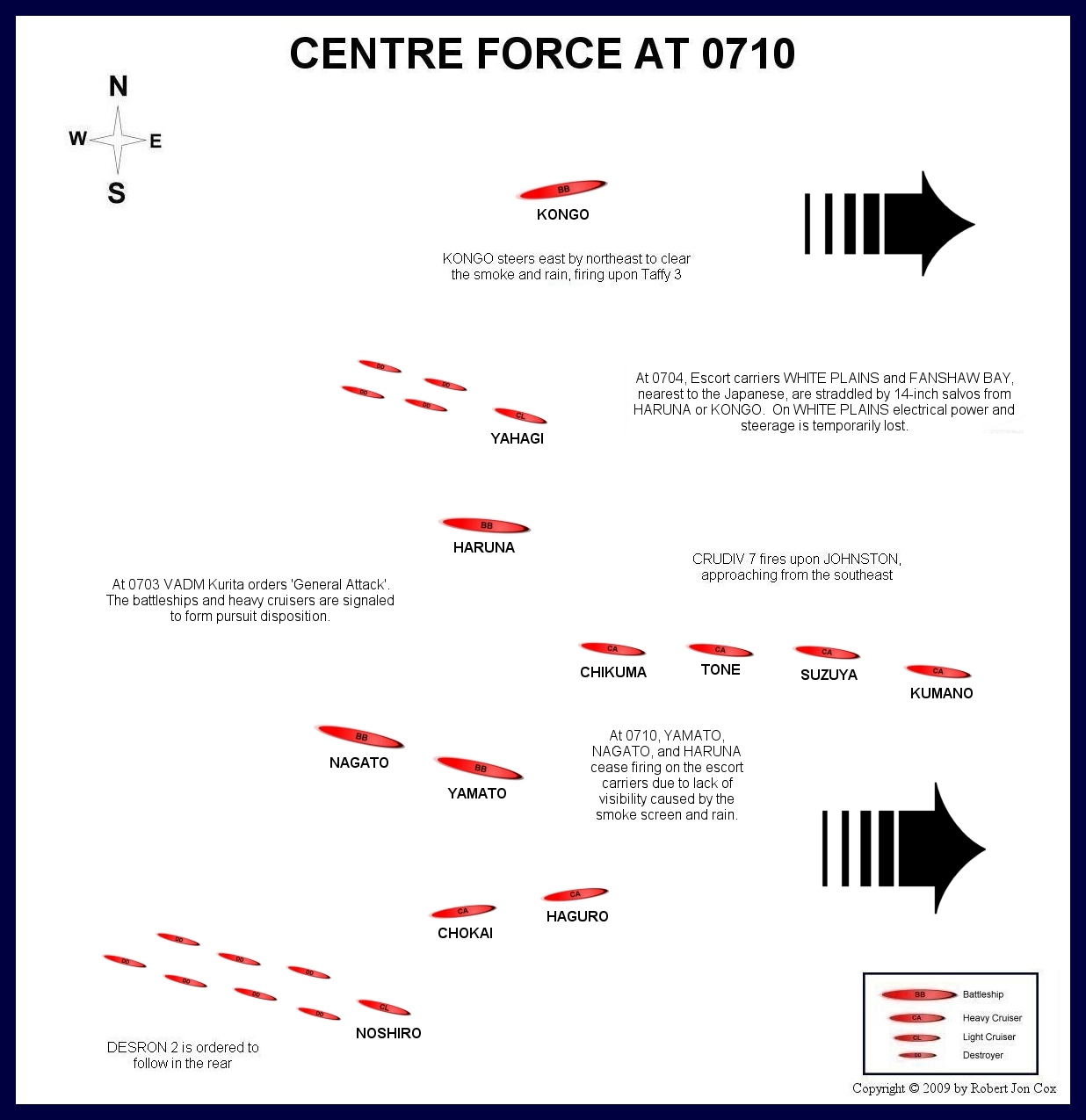
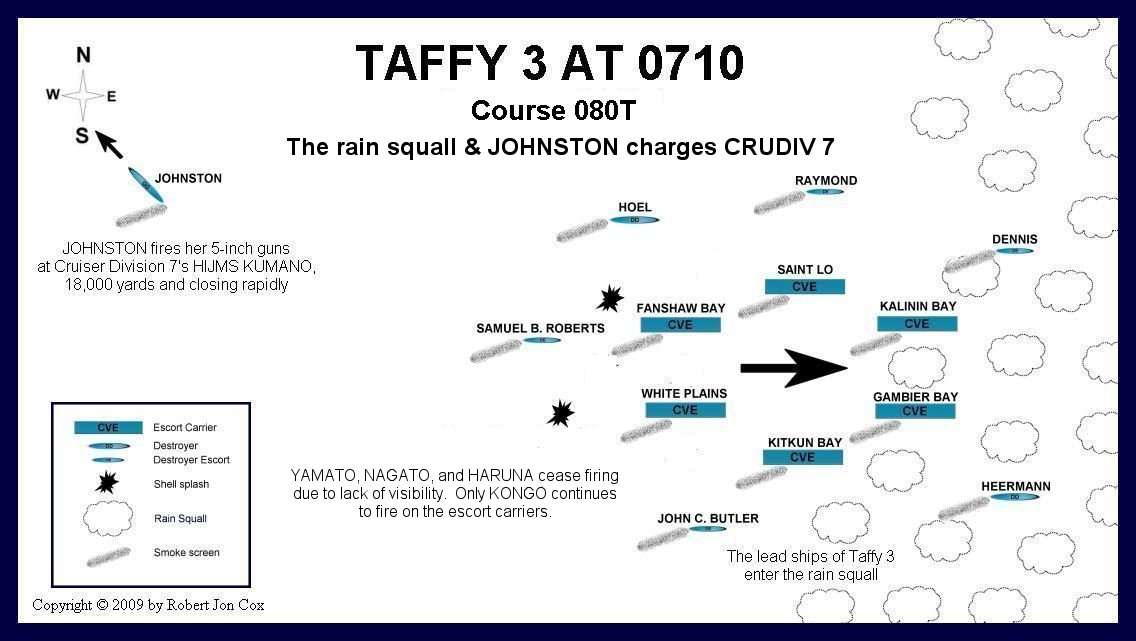
0711 TBS - v Taffy 3, "ALL SHIPS OF THIS COMMAND COME TO SHACKLE JIG BAKER UNSHACKLE."
A/C All ships of the task unit are ordered to course 080° T.
0711 On the port quarter of the task unit, DE DENNIS changes course to 000° T to take cover in a rain squall. The rain squall obscures visibility.
0713 Escort Carrier ST LO enters the rain squall which is now a driving rain. All the escort carriers are laying smoke.
| U.S. 5-INCH 38-CALIBER AMMUNITION TYPES | |
| PROJECTILE | CHARACTERISTICS |
| Common (“surface”) | Could penetrate 2”armor and were used against ship or shore targets. They had a solid nose, base fuze and tracer. |
| AA Common with Mark 18 fuze | This was the basic, multi-purpose round for anti-aircraft or surface firing or in shore bombarding. The nose fuse could be set to detonate the projectile by clock work in a pre-set interval after firing or the base fuse could detonate the projectile on contact with surface or shore target. All rounds contained a red or white tracer. |
| AA Common with Mark 32 fuze | This type was for anti-aircraft. It required no pre-setting of the nose fuse and had no base fuse or tracer. |
| Starshell | Illuminating projectiles contained a parachute-suspended flare which was ejected in flight when the Mark 18 nose fuse functioned at the pre-set time. To ensure that it did so was the job of the Elevating Indicator Regulator. There was no base fuse or tracer. |
0715 TBS - Taffy 2 v Taffy 3, "ENEMY COMPOSED OF 6 BATTLESHIPS, 8 CRUISERS, ACCOMPANYING DESTROYERS. PLEASE SEND ALL AVAILABLE PLANES TO THIS AREA."
A/C As circumstances and time permitted, RADM Sprague radioed for help and realized that the majority of assistance would come from the escort carries of Task Unit 77.4.2.
0715 Steaming eastward at flank speed, the tail-end escort carrier of Taffy III enters the rain squall. The CVEs flee in a circular formation about 2,500 yards in diameter. The escorts lay protective smoke in their rear, about 6,000 yards from the imaginary center of the formation.
0715 At a distance of about 12,000-15,000 yards IJN BB HARUNA opens fire on DD JOHNSTON and misses.
|
EVENT The escort carriers of Taffy III, now inside the protective rain squall, are ordered by RADM Sprague to turn southward toward the safety of the other Taffies, Leyte Gulf, and Seventh Fleet. A/C In his attempt to save Taffy III, RADM Sprague also wanted to draw the Japanese warships away from San Bernardino Strait and within striking distance of the ships and aircraft of the U.S. fleets. He knew the most damage would be inflicted to Centre Force in open water by the aircraft of the fleets. Taffy II was currently less than 25 miles, perhaps as close as 20 miles, southeast of Taffy III, just over the horizon. After RADM Stump had received RADM Sprague’s initial distress call, he hastily began preparing his first strike from the escort carriers of his task unit. |
Action Report “Enemy forces consisted of four battleships, 2 YAMATO and 2 ISE, four to six heavy cruisers, 2 TONE, and from seven to ten destroyers, 3 ASASHIO; 4 TERUTSUKI, all in position west of this unit and in approximate column by class with the battleships in the northern column, cruisers in the center and destroyers to the south. The interval between columns was several thousand yards (about 8000) with the column leaders on a line of bearing about 240 degrees T from north. The enemy bore about 320 degrees T, distance 17 miles from this ship at the outset of the engagement.” |
0716 Rear Admiral Sprague, sensing the danger from the Japanese cruiser line, orders his three destroyers to counterattack with torpedoes. Rear Admiral Sprague is unaware JOHNSTON has already engaged the cruisers with gunfire and is preparing to deliver the first torpedo attack.
A/C The three FLETCHER Class destroyers of Taffy III had a total of thirty torpedoes between them. The four BUTLER Class destroyer escorts combined could only muster twelve more. Knowing he was entirely out-gunned by the quickly advancing Japanese warships in every category, RADM Sprague was determined to use his destroyers primary weapons before it was too late.
0718 Inside the rain squall, a driving rain with visibility close to zero, CVE ST LO begins launching the aircraft of Composite Squadron VC-65. Four Avenger Torpedo Bombers and fifteen Wildcat Fighters are prepared for immediate launch.
A/C During the launching, the range of the enemy main body closed rapidly to 25,000 yards and on down to 22,000 yards. Main battery salvoes from both the battleships and heavy cruisers had continued landing among the CVEs.
0718 Destroyer Escort BUTLER enters the rain squall.
EVENT Destroyer HOEL, commanded by Commander L. S. Kintberger, in response to RADM Sprague’s order, turns his ship and heads west to engage the lead ships of Centre Force.
|
A/C Embarked in HOEL was Commander W. D. Thomas, the destroyer screen commander. All orders to the screening ships concerning their attack were directed to them via CDR Thomas. 0720 Already heavily in the melee with Cruiser Division Seven and in a good position to press her attack, DD JOHNSTON charges the advancing cruiser line at 27 knots. At 10,000 yards she completes her fire control solution and fires her full complement of ten torpedoes at the lead ship, CA KUMANO. The point of aim was the leading cruiser, target angle 040°, target speed 25 knots. Torpedo depth was set at 6 feet and a spread of one degree was used. All ten torpedoes are launched at three second intervals and are reported to run "hot, straight, and normal." 0720 TBS - v Taffy 3, "ALL CARRIERS REPORT WHETHER THEY HAVE LAUNCHED ALL PLANES. FIDO HAVE YOU LAUNCHED ALL PLANES? |
EM2c Glen E. Foster, USNR "When GQ was sounded I took my station (in the emergency generator room) and donned the sound powered phones and heard that the whole Jap fleet was out there. Shortly thereafter we took a hit that knocked out the aft generator. The emergency diesel generator next to me started up and I was kept busy providing emergency power. I felt numerous hits that shook the whole ship and water started flowing into the compartment . . . . we tasted the water and found it to be fresh water so we surmised that a tank or pipe had sprung a leak . . . by this time communications had been knocked out and I had no idea what was happening topside except I kept feeling the ship taking hits and I could hear and feel our forward guns firing. While I was working in front of the switchboard a hit into the forward fire room buckled the bulkhead and knocked the switchboard onto me . . . . steam started pouring into the compartment. It was then I decided it was time to get the hell out." |
GEORGIA HAVE YOU LAUNCHED ALL PLANES?" .... v FIDO, "AFFIRMATIVE." .... v GEORGIA, "WILL LET YOU KNOW."
0720 Taffy III gives the position of Centre Force as position Latitude 11°-44' North to Longitude 126°-24' East.
A/C This is the first time Taffy II could determine the bearing to the Japanese fleet. At this time Taffy II was at position Latitude 11°-21' North to Longitude 126°-44' East on bearing 141° T with a distance of about 34 miles from the main body disposition. In his Action Report, RADM Stump stated:
"It was apparent that the enemy force had passed through San Bernardino Straits during the night and was sweeping down toward Leyte Gulf. It was likewise evident, with the enemy probably coming to a southerly course and with the wind being from 025 T to 040 T, this Task Unit while launching would be on a converging course with the enemy force. While preparations for the first torpedo attack were being completed this Task Unit at 0720 changed course to 120 T, speed 17, conserving the ever decreasing distance between the enemy and this Task Unit as much as possible. It seemed best to try to gain distance to the eastward away from Leyte Gulf, the probable objective of the enemy. This was based on the hope that the enemy might not see us, or if he did see us that he would not divert to attack us, or if he did so he would send a small portion of his force which we would destroy and thus gain time to enable us to cripple him by air attacks. It was apparent immediately that the major burden of destruction of the enemy force must be the responsibility of TU 77.4.2."
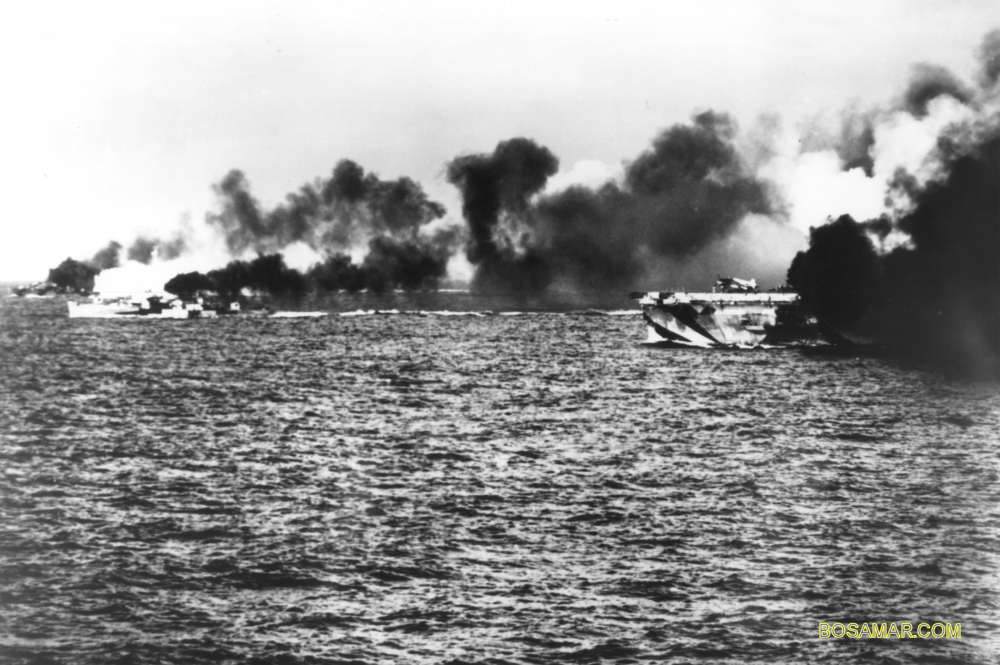
U.S. Navy Photograph
Escort Carrier USS GAMBIER BAY (CVE 73) and escorts make smoke
EVENT Immediately after delivering her torpedo attack, DD JOHNSTON reverses course and retires toward the escort carriers inside her own smoke screen.
0723 TBS - Mercury 3 v Taffy 3, "ALL SHIPS TURN SHACKLE YOKE ITEM BAKER UNSHACKLE. DERBY AND DEXTER ACKNOWLEDGE." .... v DERBY, DEXTER, "WILCO OUT."
A/C All ships of the task unit are ordered to course 110° T.
0723 Inside the rain squall, DE DENNIS changes course to 110° T.
0723 TBS - Mercury 3 v Taffy 3, "EXECUTE UPON RECEIPT TURN NINE (Course 170). DERBY AND DEXTER ACKNOWLEDGE." .... v DERBY, DEXTER, "WILCO OUT."
A/C The OTC ordered the escort carriers to turn southward. This was another pivotal point in the battle; a big gamble which paid off. Concealed by the rain squall and out of sight from the enemy, RADM Sprague gambled greatly by turning the task unit to the south and thereby decreasing the distance in which Centre Force could have to travel to cut off the task units retreat. Luck was with RADM Sprague and his task unit at this time as Centre Force blindly continued on an easternly course oblivious to the CVEs turn to the south. RADM Sprague later wrote:
"It was hard (to make this decision), because in so turning we moved in an arc - roughly semicircular - and I feared the Jap commander would cut across the diameter and blast us out of the water as we emerged from our little squall."
EVENT Destroyer Escort BUTLER is working away from the CVE formation and toward the starboard beam. Enemy warships are estimated closing at 30 knots. Many shell bursts are observed around the task unit, but no hits are observed. Several salvos land within 300-400 yards of BUTLER and several fall close astern of CVE KITKUN BAY.
|
0724 Seven miles and closing, battleship KONGŌ comes into range of DD HOEL’s guns. HOEL fires her 5-inch gun’s at the large ship at 14,000 yards. 0724 TBS - Mercury 23 v Taffy 23, "FORM 330 FROM FLEET CENTER. DE’S FORM 045 FROM FLEET CENTER." 0725 Battleship KONGŌ returns fire with her 14-inch main batteries and hits DD HOEL's bridge. The resulting explosion on DD HOEL is so violent, it is seen by VADM Kurita on board BB YAMATO who believes she blew up. Several members of HOEL's bridge control party are killed. Destroyer HOEL, still afloat, is now running on one engine and has to be steered by hand. A/C From the Japanese point of view, BB KONGŌ conducted some fine shooting that morning. Of all four battleships present, only BB KONGŌ's fire control solutions were consistently accurate and she was credited with hitting many of Taffy III’s ships. |
LT Maurice 'Fred' Green, USN "We decided to fire a half salvo at the leading battleship and save the other half for the leading cruiser because it was definite that we would have to turn at least two columns of ships in order to be of any assistance in screening the CVEs...all the Japs turned and fled. There is no explanation why. They could have rubbed out every ship in our formation... At 0725 we received the first hit on the bridge which destroyed our voice radio communications and also the remote Radar PPI on the bridge. This shell also killed several bridge personnel.... helmsman.... captain’s talker... It was less than five minutes later that we received a hit on the main battery director putting it out of action and also killing our anti-aircraft officer, making it necessary for the anti-aircraft guns to go into local control. We had an officer at each 40 mm mount...there was nothing within range of the 40 mms to fire at..." |
EVENT At 9,000 yards DD HOEL fires five of her torpedoes at BB KONGŌ which turns hard to port to evade them. Battleship KONGO fires her main battery once again and hits DD HOEL with two more 14-inch shells.
EVENT The damage from the heavy shells cause DD HOEL’s rudder to jam. As a result, she heads straight toward BB KONGŌ for two perilous minutes before steering can be shifted aft; she slowly turns away, avoiding further damage.
A/C HOEL was in rough shape by this time. After spending two minutes driving towards KONGŌ, she was able to regain control of her rudder. Now, practically directly under the guns of KONGŌ, she had to make best her retreat with only one engine.
0725 Battleship KONGŌ enters the rain squall and ceases firing on the Americans.
0725 Escort Carrier KITKUN BAY completes the launching of her 10 TBM torpedo bombers and 10 FM-2 fighters from Composite Squadron VC-5.
A/C KITKUN BAY had nearly her full complement of aircraft on board when Centre Force attacked. From the time of the initial sighting and the sounding of General Quarters it took her only about 30 minutes to ready and launch 20 aircraft. No small feat on an escort carrier, let alone one that is under fire and in a rain squall!
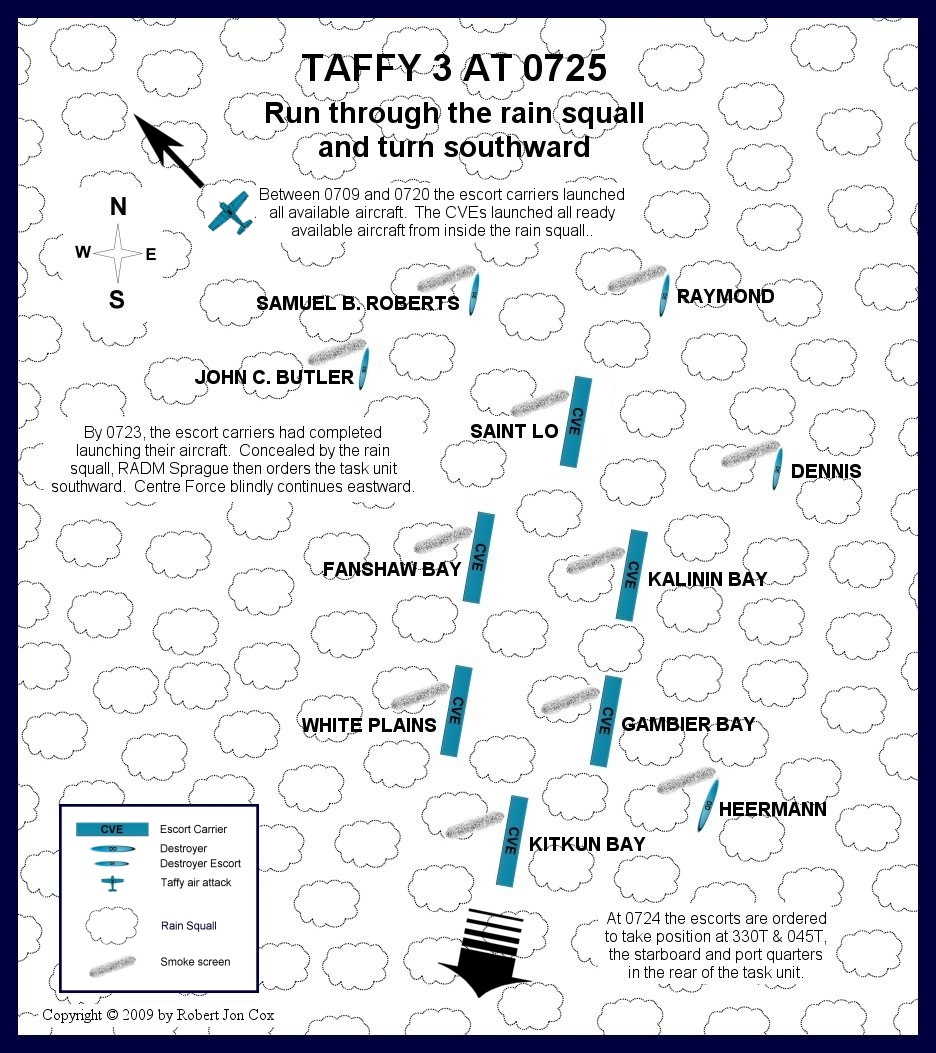
0727 Heavy cruiser KUMANO is hit by at least one torpedo from DD JOHNSTON, possibly as many as three, almost severing her bow. Critically damaged, her speed drops to 16 knots and she drops out of the cruiser formation. Results of the torpedo attack were not observed visually by JOHNSTON as she was retiring behind a heavy smoke screen when the torpedoes were scheduled to hit. Two and possibly three heavy underwater explosions were heard by two officers and many enlisted men in the repair parties at the time the torepdoes were scheduled to hit. Upon emerging from the smoke screen the leading cruiser was observed to be burning furiously astern.
A/C The Japanese cruiser division believed JOHNSTON was a BALTIMORE Class cruiser.
EVENT Heavy cruiser SUZUYA, comes under extremely heavy air attack by Taffy aircraft. She is bombed twice and badly damaged. Veering to port, her speed is limited to 23 knots due to a ruptured fuel tank.
|
EVENT With her division mate in more serious trouble than herself, CA SUZUYA stops to aid the severely wounded CA KUMANO. A/C Only one minute shy of 30 minutes into the Japanese bombardment the Americans had succeeded in placing two heavy units of Centre Force out of action for the remainder of the battle. The two MOGAMI Class heavy cruisers KUMANO and SUZUYA sported ten 8-inch guns and eight 5-inch guns apiece. Their early removal from the battle was paramount in the escape of the American task unit. Had they not been removed at this early stage, their 35 knot speed and heavy armament certainly would had given them the potential to play a major roll in the remainder of the battle. KUMANO would live one month longer, only to be sunk by Task Force 38 aircraft from the carrier TICONDEROGA. Later during the day, SUZUYA became a target for Taffy aircraft, floundered, and was scuttled by Centre Force destroyer OKINAMI. 0730 Running almost abeam of the cruiser line and with battleships closing from astern, DD JOHNSTON is hit by three 14-inch battleship shells, "...like a puppy being smacked by a truck...." Thirty seconds later she is hit again by three 6-inch projectiles. |
LT James R. Jackson, USNR The enemy fleet was in a rain squall at the time and as I entered the clouds, the rest of the air group was lost to sight. When I emerged I found that I was not on a target and since the base of the cloud was at about 1000 feet it was too late to find one, so I continued my dive in a turn to the right. This turned out to be a bad move because instead of coming out over the leading warship as planned, I discovered that we were over the starboard side of the force. We had attacked from ahead and the right turn took us over the remainder of the enemy force at less that 1000 feet altitude. I think that this move came as such a surprise to the enemy that it is the only reason we escaped. I continued the dive until we were just clearing the surface of the water. I had everything wide open and I glanced at the airspeed indicator and found that we were indicating well over three hundred knots. The air seemed to be full of tracer and exploding AA shells. The water was one mass of splashes and spouts and never before have we seen such heavy fire. |
These six critical hits knock out the after fire room and engine room reducing JOHNSTON's speed to 17 knots. All power to the steering engine, after three 5-inch guns, and gyro compass is lost. FD radar is temporarily put out of commission. The SC radar antenna is snapped off from the force of hits, rendering it useless. Five-inch guns #53 and #55 still receive indicating signals. The guns crews shift to telescope control and set sight angle and sight deflection received by plot from hand. Gun #45 is in the worse shape. It is fired in local control for the remainder of the action.
A/C As JOHNSTON and HOEL were both hit with 14-inch shells, the battleship KONGŌ was effectively engaging the destroyers. Only four Japanese warships had 6-inch batteries, they were YAMATO, KONGŌ and the two light cruisers. Although severely crippled by the 14-inch hits, these two gallant destroyers would fight on.
0730 Battleship KONGŌ executes an emergency turn to starboard as she evades the torpedoes fired earlier by DD HOEL.
A/C KONGŌ’s turn to starboard to comb HOEL’s torpedoes wakes kept her in the battle as it drew her on a course to close on the Americans.
0730 Taffy II estimates Centre Force main body bears 327° T, distance 31 miles and is possibly not aware of its presence.
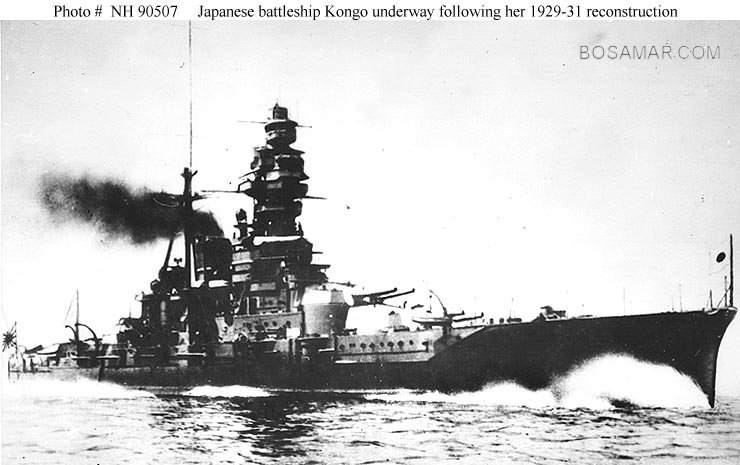
National Archives Photograph
Imperial Japanese Navy battleship HIJMS KONGŌ
0730 Destroyer Escort DENNIS changes course to 200° T.
0730 Destroyer Escort RAYMOND commences systematic firing on a heavy cruiser bearing 310° T, range 14000 and closing. Her Action Report states, "... a moderate and intermittant heavy rain with heavy clouds setting low overhead. This and the fact that all ships were making smoke reduced our visibility considerably".
EVENT Caught in the middle of the approaching Japanese warships, one of the exploding shells kills three officers on DD JOHNSTON’s bridge. In addition, the concussion from the violent explosion rips the shirt off CDR Evans. He also loses two fingers on his left hand and suffers several small shrapnel wounds to his neck and back. Undaunted by his wounds, he continues to fight his ship in a heroic and gallant manner.
EVENT Luck in the form of a rain squall finds DD JOHNSTON as she finds safe-haven in the same squall the escort carriers entered earlier. Once inside, the Japanese gunfire subsides and her men hastily begin emergency repairs to their heavily damaged ship. As soon as FD radar and Mark 6 Stable Element were back in operation the leading Japanese warship (designated a destroyer in JOHNSTON's action report) is taken under fire at a range of 10,000 yards in modified radar control. The cruisers are observed by radar to be closing Taffy III rapidly. JOHNSTON takes the closest cruiser under fire in modified radar control at a range of 11,000 yards. Approximately one hundred rounds are fired at these two targets from within the rain squall with no visual sighting.
A/C This timely sanctuary gave JOHNSTON the time she needed to fabricate emergency repairs. Her bridge was utterly ruined by her engagement with the battleships. Due to the loss of the steering engine It was during this time that CDR Evans switched steering to manual control aft, via the JV phone circuit.
| SHIP | Torpedoes | Time | TARGET/RESULTS | |
| Carried | Fired | |||
| HOEL | 10 | 5 | 0725 | BB KONGŌ, all miss |
| JOHNSTON | 10 | 10 | 0727 | CA KUMANO, one to three hits |
| Results of initial screening action. | ||||
EVENT Destroyer HOEL, with limited propulsion on one engine, is unable to put distance between herself and the Japanese warships. She continues to take heavy punishment. She is hit on her main battery director, putting it out of commission and killing the anti-aircraft officer. Her 40mm anti-aircraft guns are placed in local control.
EVENT The fleeing escort carriers reach the south side of the quick moving rain squall. With their sanctuary passing by the side, the six fleeing escort carriers now exit the other side of the rain squall and continue on a southerly course with the warships of Centre Force in hot pursuit.